
Catalog excerpts
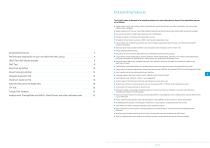
Outstanding features The Cyclus2 meets all demands of a versatile precision test- and training device. Some of the remarkable features are as follows: Highly accurate test- and training results provided by the use of the athlete’s own bike (racing bike, track racing bike, triathlon bike, handbike) Elastic suspension of the user’s own bike enables sustained load performances (also side-to-side movement possible) Non-slip transmission of high brake-resistances up to 3000 Watts Life-like simulation of training- and competition courses Simulation of slip stream races (e.g.. 4000 m team pursuit,...
Open the catalog to page 2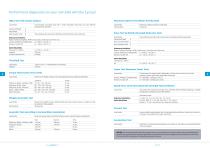
Performance diagnostics on your own bike with the Cyclus2 OBLA Test with lactate analysis Maximum Cadence Test (Motor Activity Test) Load mode Incrementally increasing load with a freely selectable initial load and user defined step-size and -duration Load mode Test duration The step duration can also be defined according to the work carried out Sinus Test by Richter (Strength Endurance Test) Initial load (Watt) Step (Watt) Maximum cadence with low initial load 6 seconds Endurance disciplines Road, Triathlon, Duathlon, MTB-CrossCountry, Track pursuit, Points race Juniors, Amateurs,...
Open the catalog to page 3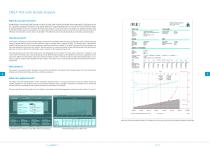
OBLA Test with lactate analysis What do we want to know? Depending on the training-/ Load intensity not only the heart rate but aiso the lactate value measurable in the biood increa- ses. The latter provides information on the oxygen supply for the energy generation in the muscle cell and therefore allows an individual determination of the load intensity and the state of fitness. Each heart rate relates to a respective lactate value in the blood. High lactate concentrations are to be avoided. Hence we have to find out at which heart rate the training is most effective as the lactate...
Open the catalog to page 4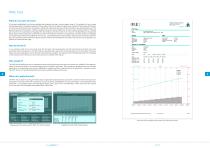
What do we want to know? It has been established, that during cascade Load schemes the heart rate increases iineariy. The gradient of the increase thereby depends on the physical capacity of the proband. Note: The higher the endurance capacity of the proband the slower is the increase of the heart rate. The objective of the test is the determination of the performance at a defined heart rate. This approach was first introduced in 1948 by a Swedish man by the name of Wahiund. He used a heart rate threshold of 170 beats per minute for his examinations. Nowadays the test relates to the heart...
Open the catalog to page 5
Sinus Test by Richter What do we want to know? The progress of the strength endurance is a significant factor for the performance of an athlete especially in cycling sports. In order to observe and analyse the strength endurance on the Cyclus2 the newly developed Sinus Test by Richter can be used. The permanent alternation between activity- and relaxation-phases is particularly motivating for the athlete resulting in a higher commitment during test and training. Sinusoidal functions have played an important role for the optimisation of biological systems ever since. The Sinus Test by...
Open the catalog to page 6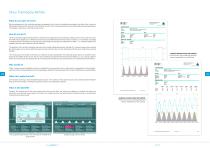
Sinus Training by Richter What do we want to know? Sinus programmes for the training have been developed on the Cycius2 in parallel and analogy to the Sinus Test in order to effectively implement the conclusions from the Sinus Test in future training practise and to specifically eliminate weaknesses. The athlete's motivation is the top priority in this. The Sinus training programmes by Richter contain the sinusoidal activity and relaxation phases as known from the Sinus Test. An initial load is applied, too. Unlike the Sinus Test the pre-defined load maxima remain constant, i.e. the athlete...
Open the catalog to page 7
Wingate Anaerobic Test What do we want to know? The Wingate Anaerobic Test (WAnT), in common terms often just caiied Wingate Test, belongs to the anaerobe test procedures in performance diagnostics amongst which it ist the most common. The athlete has to perform under a rotatio- nai-speed-dependent Load in relation to his body weight for a short time span, 30 seconds in most cases. The maximum power (Peak Power PP) therefore settles at the maximum cadence. After reaching the maximum power a steady power decrease towards the end of the test can be observed. The peak power ought to be...
Open the catalog to page 8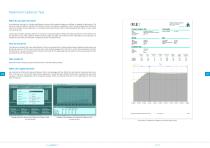
Maximum Cadence Test What do we want to know? In professional cycling it is of great significance to know which maximal cadence an athlete is capable of performing. The maximal achieved cadence indicates the athlete's motoric-coordinative capabilities, which are genetically determined and have to be trained during adolescence. In cycling the test also indicates which cycling disciplines the athlete is more suited Continually increasing average cadences in the various cycling disciplines indicate the great significance of the cadence for the sportive success. High cadences enable a better...
Open the catalog to page 9
Isokinetic Maximum Strength Test What do we want to know? The dynamic maximum strength in isokinetic Load mode is measured in relation to the cadence. Some athletes perform their maximum strength at 80 rpm, others may need more momentum for that. In contrast to the static measurement is the dyna- mic measurement (in motion) much more practice-oriented. Note, that during training or competition an immense exertion of strength, in most of the cases, is carried out in motion, e.g. during sprint activities. The desired test cadence is to be set. During the test the Load is controlled i.e....
Open the catalog to page 10
What do we want to know? How much impact does a single heartbeat have? The measurement of the CPI value - Sorry: CARDIO PERFORMANCE INDICATOR or simply: work per heartbeat renders very differentiated and detailed information on the fitness state of the test person. The excellent reproducibility of the test allows a continuous efficiency control as even the slightest changes in the fitness state can be precisely reported. Cross-reference to other people is possible but for most people not of interest. The fact, that one can detect one's own performance increase, even if it's small, is far...
Open the catalog to page 11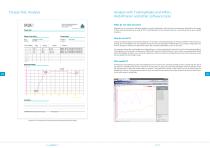
Torque Test: Analysis Institute of performance diagnostics [Hare is Your logo] Bike ergometr/ of Your own road Dike Torque Test Protocol data Romanowski, Thomas Topel, Danie © 2008 RBM elektronik-ajtomation GmbH, Leipzig Print-out of a Torque Test from MS Excei with imported Cycius2 data Analysis with TrainingPeaks and WKO+, Web4Trainer and other software tools What do we want to know? Whether bar- or curve-chart, reference analysis or specific calculation- with the various transmission methods for the range of test- and training data to an external PC or training portal on the internet...
Open the catalog to page 12All RBM elektronik-automation catalogs and technical brochures
-
Eccentric Cycle Training
6 Pages
-
Cyclus2 - Technical data
2 Pages
-
The Ergometer for Pros
12 Pages





